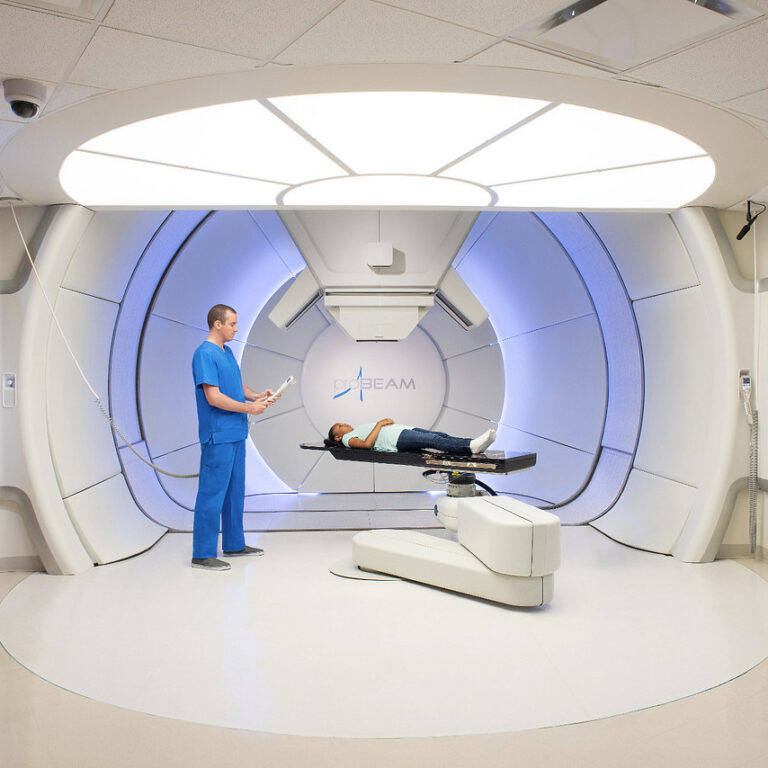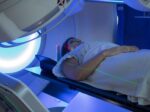Article last updated: October, 2024
Proton beam therapy is an advanced and very targeted type of external beam radiation therapy that has been proven to effective and advantageous in treating some forms of cancer.
Newer methods of radiation therapy, such as proton beam therapy, are very precise and can deliver a high dose of radiation to cancer cells while minimising damage to healthy tissue. This can improve the effectiveness of traditional photon radiotherapy and reduce the risk of side effects.
How does radiation treat cancer?
Radiation is a natural energy that usually takes the form of sound, heat or light and surrounds us safely all the time. In high levels, however, radiation has the potential to damage our DNA and cause harm and it is this process that scientists have harnessed to effectively damage cancer cells so that they can’t reproduce and eventually die.
How does traditional radiation therapy differ from proton beam treatment?
Over the years, radiation technology has become more and more precise. This accuracy is important because radiation can damage healthy tissue as well as cancerous tissue. If healthy organs and tissue are damaged people can suffer harmful and unpleasant long-term side effects.
There are two types of radiation particles that are used in treating cancer: photons and protons. They may sound very similar but they have some key differences:
1. Photons
A photon is a tiny bundle of electromagnetic energy. Nature’s basic unit of light, they are fundamental to everything around us.
Regular radiotherapy treatment uses photons in high doses. They do a great job of damaging cancerous cells, but by their nature, they keep moving and once inside the body, they also have to come out of it. Doctors and physicists have become very adept at minimalising the risk of damage caused by an ‘exit dose’ of photons, but with some cancers, it can be preferable not to have one at all.
2. Protons
A proton is a positively charged particle found in the nuclei of all atoms. Based on their physical mass, it is possible to stop proton particles at a certain depth inside the body, which means there is no exit dose. This can be advantageous for several reasons.
The benefits of proton beam therapy
In general, proton beam therapy delivers radiation treatment with less impact on nearby healthy tissues and organs – which in turn can result in fewer long-term side effects and improved quality of life.
The superior targeting of proton beam therapy while reducing dose to normal tissues means that for some tumours it is possible to deliver a higher radiation dose than other radiation therapies, which may improve long-term control of the tumour, and potentially increase cure rates.
While it is not a universal cure-all, the added precision that proton beam therapy offers makes it particularly effective for treating children with cancer as it reduces the detrimental impact some treatments can have on small and developing bodies.
The added precision is also beneficial for treating tumours in places which are near critical organs which will cause problems if damaged, such as the lungs, spinal cord, heart and brain.
How is proton therapy delivered?
Proton beam therapy is delivered in a special treatment room via a machine called a gantry. The patient is positioned carefully on a treatment table, or couch by the treatment team and the gantry rotates 360 degrees around the patient, painlessly delivering the proton beams from different angles. The proton beam machine does not touch the patient but just moves around them.
How long does proton therapy take?
People receiving proton beam therapy will generally not need to stay in hospital and it is therefore considered an outpatient treatment.
A prescribed treatment session of proton therapy should take around 30 to 45 minutes in total. Patients will normally need to attend for 5 consecutive days and have the same treatment for a period of up to 8 weeks.
For many people, this can make accessing treatment logistically challenging. Patients travelling from outside the region will need to have accommodation during their stay, in some cases for a couple of months.
A lot will also depend on the nature of your cancer treatment and whether the proton therapy is being used in conjunction with other therapies.
Who can be treated with proton beam therapy?
Because it is highly targeted, proton beam therapy can be used to treat a variety of different cancers. It is particularly useful as a tool for treating cancers in children.
In adults and the elderly, it is often used where a tumour is located in a place near critical organs or tissue that will cause undesirable side effects if damaged.
What types of cancer is proton therapy used for?
Proton beam therapy is a vital tool in helping to treat cancers where a tumour is close to organs such as the brain, spinal cord, lungs or heart or critical structures, such as head and neck cancers, and spinal or brain cancers.
While proton beam therapy is often used on its own, it can be combined with other therapies such as surgery and chemotherapy to treat a wide range of tumours.
Benefits of proton beam therapy
Proton beam therapy (PBT) is considered an effective and suitable treatment option for certain types of cancers for several reasons:
- It can be precisely aimed and controlled to deliver radiation to a tumour while avoiding exposing surrounding healthy tissue, organs and critical structures to unnecessary radiation, particularly beyond the tumour – called the ‘exit dose’.
- By sparing healthy tissue, PBT can potentially reduce acute toxicities during and shortly after treatment, and late side effects and toxicities in the months and years after treatment
- The accuracy with which PBT can be delivered and the normal tissue spared can allow a high(er) dose of radiation to the tumour, which can be particularly effective for certain types of cancers that require high radiation doses to be effectively treated.
- Research studies suggest that PBT can result in improved outcomes for certain cancers in terms of potentially increasing tumour control, and reducing long-term side effects of treatment
Limitations of proton beam therapy
One of the main limitations of proton beam therapy (PBT) is access. Although availability is increasing globally, many countries still lack the facilities to provide this treatment, necessitating international patients to travel abroad for care. Even patients within countries with PBT facilities often have to travel long distances and stay away from home for treatment which can be practically difficult.
In the UK, another limitation is that proton beam therapy is not approved for treating all types of cancer. At Proton International London, we are actively expanding the range of tumour types that we can treat, with the hope of providing more patients diagnosed with cancer access to this advanced treatment.
Additionally, PBT treatments are complex and time-consuming to deliver which means that treatment times on the radiotherapy treatment couch can be much longer than photon radiotherapy treatments, up to an hour compared with just a few minutes. This can be challenging for patients if staying still for long periods of time is difficult or uncomfortable for them.
All of these factors need to be taken into account when deciding whether PBT is the right treatment for a patient.
Alternatives to proton therapy treatment
Several alternative treatment options exist, depending on the type of cancer, its stage, and individual patient factors. These may include photon radiotherapy (conventional radiation therapy); stereotactic body radiotherapy (SBRT) which is a highly focussed form of photon radiotherapy; drug treatments including chemotherapy, immunotherapy, and hormone therapy; and surgery.
Where is proton beam therapy available in the UK?
There are two proton therapy centres in the UK where proton beam therapy is currently available. The first clinic was set up in The Christie Hospital in Manchester and that was followed by one in University College Hospital London (UCLH).
Between them, these proton beam therapy clinics treat around 650 NHS patients every year. Proton International London at UCLH is the only private proton therapy centre in the UK.
Is proton beam therapy available privately in the UK?
Yes, proton beam therapy is available privately in London. At University College Hospital private proton beam therapy is provided by Proton International London.
How much does private proton therapy treatment cost?
The cost of proton beam therapy can vary significantly depending on various factors such as the type of cancer being treated, the complexity of the case, the individual patient’s treatment needs and the number of treatment sessions required, as well as whether additional services or accommodations are required.
Why choose Proton International London?
Proton International London is part of Proton International, which has more than 30 years’ experience of in treating patients using proton beam therapy, mainly in the USA. They opened the UK’s first private proton beam therapy clinic in London offering proton beam therapy to both insured and self-pay patients who may not be able to access it via the NHS, including those from abroad.
The Proton International London team work in partnership with the world-class radiation oncologists, physicists and dosimetrists at UCLH to enable more people to benefit from proton beam therapy. Contact us today for more information about proton beam therapy.
Summary
Proton beam therapy is an effective cancer treatment option for several reasons:
Proton beams can be precisely aimed and controlled to deliver radiation to a tumour while sparing surrounding healthy tissue, which is important for tumours that are located near critical structures.
By sparing healthy tissue, proton beam therapy can potentially reduce the risk of side effects and improve outcomes for patients. Reducing long-term side effects is particularly important for children and younger patients.
Proton beams can deliver a high dose of radiation to the tumour, which can be particularly effective for certain types of tumours that are resistant to other treatments.
Early studies suggest that PBT can result in high rates of tumour control and fewer side effects for certain types of tumours.
Some insurers will cover the cost of proton beam therapy if it is considered clinically necessary. Some patients will pay for the cost of proton beam therapy themselves.
FAQs about proton beam therapy
To learn more about how proton beam therapy works, read our frequently asked questions below or contact us today:
What is a gantry?
A proton beam therapy gantry delivers the proton beam to patients in the treatment room, it is a frame structure that includes a mechanical arm which spans and moves around a patient on a couch delivering a carefully planned dose of radiation from different angles.
Is proton beam therapy well-researched?
About 170,000 people have been treated worldwide with proton beam therapy and it has gained significant attention and undergone extensive research worldwide due to its potential advantages over conventional radiation therapy.
Clinical trials have investigated the efficacy of proton beam therapy and this work is ongoing to provide more evidence of the effectiveness of proton beam therapy in a wider range of tumours. These trials aim to assess treatment outcomes, side effects, and long-term benefits in different cancer types. The results of these trials contribute to the growing body of evidence on proton beam therapy.
Researchers have explored its efficacy in improving tumour control rates and reducing side effects compared to conventional radiation therapy and there is promising evidence in specific cancer types.
This is still a developing technology and more research is needed to establish its efficacy compared to conventional radiation therapy and other treatment modalities but it certainly has the potential to transform radiation therapy around the globe.
Is proton beam therapy NICE-approved?
NICE has approved proton beam therapy for certain kinds of cancers, particularly those that include paediatric, brain, spine, and head and neck tumours.
Whether a patient is suitable or eligible for this type of treatment will depend on a wide range of factors – in some cases more conventional radiation therapy still offers the best outcome. It may be the case that, in the future, we will have more proton beam therapy centres in the UK and NICE will widen their scope of how it is used.
Does the NHS provide proton therapy treatment?
In the UK the cost of proton beam therapy may be covered by the National Health Service, but there may be specific criteria and guidelines for eligibility. The NHS sends an average of 650 patients per year for proton beam therapy at The Christie in Manchester and at University College Hospital.





